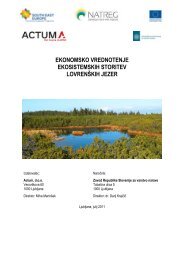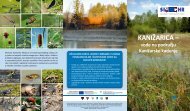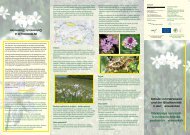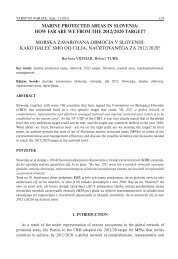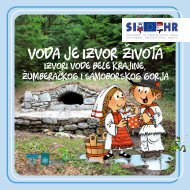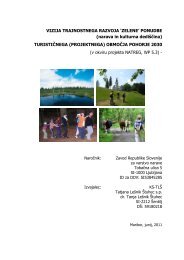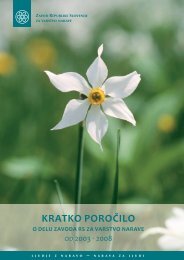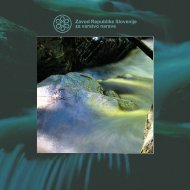UÄÂna sprehajalna pot RaÄÂa v obÄÂini MoravÄÂe - Zavod RS za varstvo ...
UÄÂna sprehajalna pot RaÄÂa v obÄÂini MoravÄÂe - Zavod RS za varstvo ...
UÄÂna sprehajalna pot RaÄÂa v obÄÂini MoravÄÂe - Zavod RS za varstvo ...
Create successful ePaper yourself
Turn your PDF publications into a flip-book with our unique Google optimized e-Paper software.
fruit-tree growers and stimulatedmany farmers to take interest in thisbranch of agriculture. On the basis ofhis rich practical experience he alsowrote one of the first Slovene books onthis subject, entitled Kranjski vertnar(The Carniolan Gardener). In thosetimes, fruit-trees stood primarily inthe immediate vicinity of the peoples’homes and along the roads leading tothe larger towns in the Gorenjska region.Apart from getting people accustomedto fruit-growing, these treesplanted along the roads had a verysimilar role as today’s cat’s eyes alongthe asphalt roads. They showed theroad’s edge to the carters.Old orchards are often called highstemmed-treeor meadow orchards.Their very names tell us that the surfaceunder their crowns was alwaysaccessible and overgrown with grass.Under fruit-trees cattle was grazing,or the fruit-tree meadows were mown.Thus the same surfaces were used notonly as orchards but meadows as well.With small investments, the farms’ incomewas supplemented. At everyhouse, fruit brandy and dried fruitscould be obtained at any time.Traditional orchard is a very interestingecosystem, in fact comparable withwell lit-through deciduous woodlands.Its fruit-trees can be up to 200 yearsold, and even more. As forest and grasslandecosystems interact in this type oforchards, they are known for their exceptionalbiodiversity, since as many as5, 000 different plant and animalspecies can be found in them, as wellas numerous fungus and lichen5859glez itd., večja tudi lesne sove in čuki.Ptice niso edine prebivalke dupel.Uporabljajo jih tudi polhi, kune, podlasice,netopirji, ose, čebele in drugeživali. Če so sadovnjaki v stiku z gozdomin živimi mejami, v bližini pa jevoda, je pestrost vrst še posebej bogata.Žal mnogi stari sadovnjaki izginjajo.Posekajo jih, da travnik pod njimi lažekosijo. Površine s starimi drevesi pozidajo,ponekod, kjer se prebivalstvo izseljuje,jih preraščajo gozdovi. Njihovovlogo pridelave sadja prevzemajo intenzivnisadovnjaki novih, občutljivihsort, ki <strong>pot</strong>rebujejo intenzivno, dragovzdrževanje z rednim <strong>za</strong>tiranjem različnihbolezni.Mnogi stari sadovnjaki na srečo še vednobogatijo podobo vasi. Eden izmednjih je tudi Smrkoljev sadovnjakv Krašcah. Ob njihovi hiši rastejo hruškeprapršnice in črnjevke, jablane bobovec,krivopecelj in voščenka ter orehiin slive.pridelavi sadja. Na podlagi svojih bogatihpraktičnih izkušenj je napisal tudieno prvih slovenskih knjig o sadjarstvuz naslovom Kranjski vertnar. Sadnadrevesa so v tistih časih sadili predvsemv okolici hiš ter ob <strong>pot</strong>eh v večjekraje na Gorenjskem. Poleg navajanjaljudi na sadjerejo so imela drevesa ob<strong>pot</strong>eh v vasi podobno vlogo kot danesmačja očesa ob današnjih asfaltnih<strong>pot</strong>eh. Voznikom so ka<strong>za</strong>la rob vozišča.Starim sadovnjakom pogosto rečemovisokodebelni ali travniški sadovnjaki.Že ime pove, da je bila površinapod krošnjami dostopna in porasla stravo. Pod sadnim drevjem se je paslaživina ali pa so travnike pod sadnimdrevjem kosili. Tako je bila ista površinauporabna tako <strong>za</strong> pridelavo sadjakot travnik. Z majhnimi vlaganji sodopolnjevali dohodek kmetije. Dobersadjevec in krhlje je imela vsaka hiša.Tradicionalen sadovnjak je zelo <strong>za</strong>nimivekosistem, ki bi ga lahko primerjalitudi z redkim svetlim listnatimgozdom. Sadna drevesa lahko dočakajo200 let in več. Ker se v njem mešatagozdni in travniški ekosistem, je <strong>za</strong>njznačilna izjemna pestrost živih bitij,saj lahko v takih sadovnjakih najdemocelo do 5000 različnih vrst rastlin in živalipa tudi mnoge vrste gliv in lišajev.Poleg dreves so med rastlinami najboljopazne različne vrste trav in cvetlic,med živalmi pa ptiči in metulji. Posebnovrednost v sadovnjaku imajo drevesaz dupli, ki jih v debla in debele veje votlihali delno trhlih dreves iztešejo detliin žolne, predvsem pivka. Ko se odselijo,njihova dupla <strong>za</strong>sedejo nekaterevrste sinic, pogorelček, vijeglavka, brspecies.Particularly noticeable amongthe plants are, apart from the treesthemselves, different grass and flowerspecies, as well as numerous birds andbutterflies. Of special value in these orchardsare trees with holes, made intrunks and thick branches of hollow orpartially putrid trees by woodpeckers,especially by the Grey-headed Woodpecker.When they move away, theirholes are occupied by some tit species,Redstart, Wryneck, Nuthatch, etc., thelarger holes even by Tawny and LittleOwls. Birds, however, are not the onlyinhabitants of tree holes. They are alsoused by dormice, martens, weasels,bats, wasps, bees, and other animals.If the orchards are in contact withwoodlands and hedges, and there happensto be water nearby, their biodiversityis even greater.Unfortunately, many traditional orchardsare disappearing rapidly. Theyare usually cut down in order to mitigatemowing of the meadows underthem. Surfaces with old trees are builtup, and in places where their ownersleft for larger towns, they are graduallyovergrown by forests. Thus theirrole of fruit-growing is assumed byintensively-farmed orchards with new,sensible varieties, which are in needof intensive, expensive maintenancewith regular extermination of variousillnesses.Luckily, there are some traditional orchardsthat are still enriching the imageof old villages. One of them is Smrkoljevorchard at Krašce. In it, severalapple and pear varieties are still thriving,as well as nut and plum trees.



